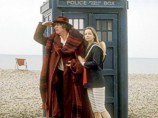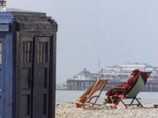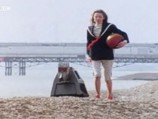 |
|
The Doctor and Romana at Brighton
|
|
 The Doctor, Romana and K9 are attempting to enjoy themselves on Brighton beach. But it comes to a sudden end when K9 becomes incapacitated when he has an unfortunate accident after entering the sea to retrieve a beech ball. The Doctor, Romana and K9 are attempting to enjoy themselves on Brighton beach. But it comes to a sudden end when K9 becomes incapacitated when he has an unfortunate accident after entering the sea to retrieve a beech ball.
 After this abortive holiday, Romana persuades The Doctor to visit a giant pleasure dome, The Leisure Hive, on the planet Argolis. They arrive there in the year 2290 where the surface of the planet has become uninhabitable following a twenty minute nuclear war between the Argolins and their enemies the Foamasi. After this abortive holiday, Romana persuades The Doctor to visit a giant pleasure dome, The Leisure Hive, on the planet Argolis. They arrive there in the year 2290 where the surface of the planet has become uninhabitable following a twenty minute nuclear war between the Argolins and their enemies the Foamasi.
 The Argolins are dying. The radiation on their planet’s surface having rendered them sterile. It is revealed that Pangol, the youngest Argolin alive, was actually created by the Tachyon Recreation Generator, a machine used to generate games in The Leisure Hive. The Argolins are dying. The radiation on their planet’s surface having rendered them sterile. It is revealed that Pangol, the youngest Argolin alive, was actually created by the Tachyon Recreation Generator, a machine used to generate games in The Leisure Hive.
 | | The Doctor on the Beach |
|
 Curious about the Tachyon Recreation Generator, The Doctor enters the machine to investigate it but unseen by anyone a Foamasi operates the controls, trapping him inside. Then, as Romana tries to open the door, an image of The Doctor appears on a view screen and screams as his arms and lower torso are pulled off. Curious about the Tachyon Recreation Generator, The Doctor enters the machine to investigate it but unseen by anyone a Foamasi operates the controls, trapping him inside. Then, as Romana tries to open the door, an image of The Doctor appears on a view screen and screams as his arms and lower torso are pulled off.
 Thankfully this is just a projection and so The Doctor is not harmed. The Doctor and Romana then meet Earth scientist Hardin and agree to help him test alterations that he has made to the machine. But as The Doctor enters the Tachyon Recreation Generator, Romana, on returning to Hardin’s lab, realises that the alterations that have been made are is flawed and that Hardin had been faking his work. But she fails to stop the experiment in time and so when The Doctor exits from the machine it is discovered he has aged immensely and now has a long white beard. Thankfully this is just a projection and so The Doctor is not harmed. The Doctor and Romana then meet Earth scientist Hardin and agree to help him test alterations that he has made to the machine. But as The Doctor enters the Tachyon Recreation Generator, Romana, on returning to Hardin’s lab, realises that the alterations that have been made are is flawed and that Hardin had been faking his work. But she fails to stop the experiment in time and so when The Doctor exits from the machine it is discovered he has aged immensely and now has a long white beard.
 | | K9 and Romana |
|
 Then the Argolin’s Earth agent, Brock, arrives with his lawyer Klout, bearing an offer to buy the planet outright. Regrettably the offer is from the Foamasi, the only species that could live on the radiation-infused surface of Argolis, and so the Argolin Board, including Pangol who vehemently opposes this plan, will not consider it even though The Leisure Hive is facing bankruptcy. Hit by the shock of events, the ageing Board Chairman Morix succumbs to a rapid death – the Argolin war curse of advanced cellular degradation – and his consort Mena, the mother of Pangol, is declared the new Chairman. Then the Argolin’s Earth agent, Brock, arrives with his lawyer Klout, bearing an offer to buy the planet outright. Regrettably the offer is from the Foamasi, the only species that could live on the radiation-infused surface of Argolis, and so the Argolin Board, including Pangol who vehemently opposes this plan, will not consider it even though The Leisure Hive is facing bankruptcy. Hit by the shock of events, the ageing Board Chairman Morix succumbs to a rapid death – the Argolin war curse of advanced cellular degradation – and his consort Mena, the mother of Pangol, is declared the new Chairman.
 The Doctor and Romana then discover that Pangol is secretly planning to use the Tachyon Recreation Generator to recreate himself many times over, forming an army of duplicates to destroy the Foamasi for good. The Doctor and Romana then discover that Pangol is secretly planning to use the Tachyon Recreation Generator to recreate himself many times over, forming an army of duplicates to destroy the Foamasi for good.
 But as Mena herself grows weaker, Pangol takes the opportunity to take command and attempts to create his army. However, The Doctor has tampered with the equipment and an army of Doctors emerges instead. But the duplicates are unstable and quickly vanish. But as Mena herself grows weaker, Pangol takes the opportunity to take command and attempts to create his army. However, The Doctor has tampered with the equipment and an army of Doctors emerges instead. But the duplicates are unstable and quickly vanish.
 | | Romana |
|
 The Leisure Hive turns out to have been infiltrated by some Foamasi agents from their planet’s government, who expose Brock and his assistant, Klout, as doppelgangers in bodysuits. They are in fact renegade Foamasi members of the West Lodge - a criminal faction which has been sabotaging The Leisure Hive to help their negotiations. The Foamasi agents place them under arrest and prepare to depart. The Leisure Hive turns out to have been infiltrated by some Foamasi agents from their planet’s government, who expose Brock and his assistant, Klout, as doppelgangers in bodysuits. They are in fact renegade Foamasi members of the West Lodge - a criminal faction which has been sabotaging The Leisure Hive to help their negotiations. The Foamasi agents place them under arrest and prepare to depart.
 Pangol then starts to clone himself in the Tachyon Recreation Generator, creating hundred of Pangols in battle-dress and ready for conflict. But like the early clones of The Doctor, Pangol’s clones also become unstable and disappear. Pangol then starts to clone himself in the Tachyon Recreation Generator, creating hundred of Pangols in battle-dress and ready for conflict. But like the early clones of The Doctor, Pangol’s clones also become unstable and disappear.
 So that he can revert back to his proper age The Doctor then reconfigures the Tachyon Recreation Generator using components from the randomiser device previously linked to the TARDIS’s navigation circuits. Unaware of this Mena and Pangol enter the Tachyon Recreation Generator and are rejuvenated - Mena into a young woman and Pangol into a baby. The Doctor then enters the machine himself and loses his added centuries. This though has the unfortunate outcome of the loss of the Randomiser. So that he can revert back to his proper age The Doctor then reconfigures the Tachyon Recreation Generator using components from the randomiser device previously linked to the TARDIS’s navigation circuits. Unaware of this Mena and Pangol enter the Tachyon Recreation Generator and are rejuvenated - Mena into a young woman and Pangol into a baby. The Doctor then enters the machine himself and loses his added centuries. This though has the unfortunate outcome of the loss of the Randomiser.
 With the Foamasi West Lodge members exposed The Doctor and Romana leave Argolis to sort out its problems, with Mena back in charge. With the Foamasi West Lodge members exposed The Doctor and Romana leave Argolis to sort out its problems, with Mena back in charge.
|